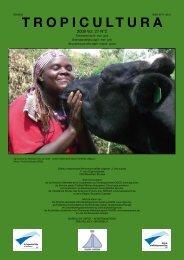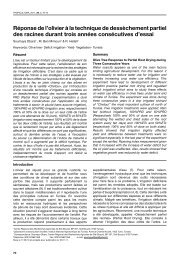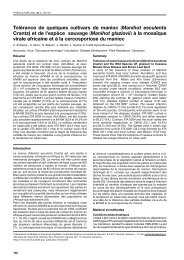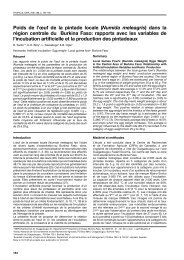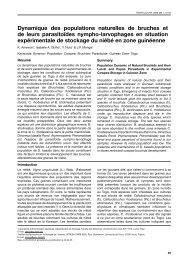Fascicule entier - Tropicultura
Fascicule entier - Tropicultura
Fascicule entier - Tropicultura
You also want an ePaper? Increase the reach of your titles
YUMPU automatically turns print PDFs into web optimized ePapers that Google loves.
Summary<br />
The levels and activities of a number of plant secondary<br />
metabolites (PSMs) are known to increase in response<br />
to increase in stress. The Mongolian plants considered<br />
to possess medicinal properties may contain novel<br />
compounds since they are exposed to severe<br />
conditions; such plants could become good candidates<br />
for modern drug discovery programmes. Information<br />
on distribution, palatability to livestock and opinion of<br />
local people on their nutritive and medicinal values was<br />
compiled for 15 plant materials from 14 plant species<br />
considered important for medicinal purposes. These<br />
plants were evaluated for nutritive value and PSMs:<br />
tannins, saponins, lectins, alkaloids and cyanogens.<br />
High levels of tannins were found in roots of Bergenia<br />
crassifolia and in leaves of B. crassifolia, Vaccinium<br />
vitisidaea and Rheum undulatum. High lectin activity<br />
(haemagglutination) was present in B. crassifolia roots,<br />
and leaves of R. undulatum, Iris lacteal and Thymus<br />
gobicus contained weak lectin activity. Tanacetum<br />
vulgare, Serratula centauroids, Taraxacum officinale<br />
and Delphinum elatum leaves contained saponin<br />
activity (haemolysis). Alkaloids and cyanogens were<br />
not present in any of the samples. The paper discusses<br />
the known medicinal uses of these plants in light of the<br />
PSMs levels, and identifies plant samples for future<br />
applications in human and livestock health, welfare and<br />
safety.<br />
1Institute for Animal Production in the Tropics and Subtropics (480b), University of Hohenheim, 70593 Stuttgart, Germany.<br />
2Mongolian State University of Agricultural, Mongolia.<br />
3Veterinary Research Institute, Mongolia.<br />
*Corresponding author: H.P.S. Makkar: e-mail: makkar@uni-hohenheim.de, Tel: +4971145923640, Fax: +4971145923702<br />
Received on 28.01.09 and accepted for publication on 08.06.09.<br />
TROPICULTURA, 2009, 27, 3, 159-167<br />
Plant Secondary Metabolites in some Medicinal Plants<br />
of Mongolia Used for Enhancing Animal Health and<br />
Production<br />
H.P.S. Makkar 1 *, T. Norvsambuu 2 , S. Lkhagvatseren 3 & K. Becker 1<br />
Keywords: Medicinal plants- Herbs- Plant secondary metabolities- Phytochemicals- Phytotherapy- Mongolia<br />
Introduction<br />
The use of various herbs and medicinal plants has a<br />
long history. They have been used since ancient times,<br />
especially in oriental countries. However, the advent<br />
Résumé<br />
Métabolites secondaires végétaux de quelques<br />
plantes médicinales de la Mongolie utilisées pour<br />
améliorer la santé et la production animale<br />
Les niveaux et activités d’un certain nombre de<br />
métabolites secondaires végétaux (plant secondary<br />
metabolites, PSMs) sont connus pour augmenter à<br />
la suite de stress croissant. Les plantes mongoles,<br />
censées avoir des propriétés médicinales, pourraient<br />
contenir de nouveaux composés puisqu’elles sont<br />
exposées aux conditions environnementales rudes.<br />
De telles plantes seraient de bons candidats pour des<br />
programmes modernes de découverte de drogue.<br />
Des informations sur la distribution, la sapidité pour le<br />
bétail et l’opinion de la population locale concernant les<br />
valeurs nutritives et médicinales ont été rassemblées<br />
pour 15 matières végétales provenant de 14 espèces de<br />
plantes considérées importantes dans des applications<br />
médicinales. Ces plantes on été évaluées concernant<br />
leur valeur nutritive et les PSMs: tannins, saponines,<br />
lectines, alcaloïdes et cyanogènes. Des niveaux élevés<br />
en tannins ont été trouvés dans les racines de Bergenia<br />
crassifolia ainsi que dans les feuilles de B. crassifolia,<br />
Vaccinium vitisidaea et Rheum undulatum. Une activité<br />
élevée de lectin (hémagglutination) était présente dans<br />
des racines de B. crassifolia, tandis que des feuilles de R.<br />
undulatum, Iris lacteal et Thymus gobicus démontraient<br />
une faible activité de lectin. Les feuilles de Tanacetum<br />
vulgare, Serratula centauroids, Taraxacum officinale<br />
et Delphinum elatum démontraient une activité de<br />
saponines (hémolyse). Des alcaloïdes et cyanogènes<br />
n’étaient pas présents dans ces échantillons. Cette<br />
publication discute des applications médicinales<br />
connues de ces plantes devant de niveaux PSMs, et<br />
identifie des échantillons de plante pour de futures<br />
applications au service de la santé des êtres humains et<br />
du bétail, leur bien-être et sécurité.<br />
of antibiotics in early 20 th century led to decline in<br />
their usage and waned interest in providing scientific<br />
bases to their effects. The adverse effects of using<br />
159



